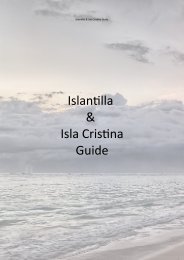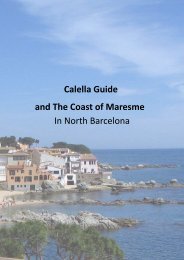Comma Spanish orthography course
This is a Small guide to learn how to use the Comma in Spanish Language
This is a Small guide to learn how to use the Comma in Spanish Language
Create successful ePaper yourself
Turn your PDF publications into a flip-book with our unique Google optimized e-Paper software.
<strong>Comma</strong> <strong>Spanish</strong> <strong>orthography</strong> <strong>course</strong><br />
<strong>Comma</strong> has some rules in spanish that are very similar to english, but they also are a bit different.<br />
When a sentence is interrupted, and to cite or indicate the subject or work which has been taken,<br />
and because it is inserted in passing another that clarifies or expands what is being said, these<br />
words, which temporarily suspended the main story, They are enclosed between two commas; v.<br />
gr .: The truth, writes a politician has to support with reasons and authorities; Southerly winds<br />
than in those burning regions are very common, pose a serious conflict travelers.<br />
•Cuando una oración se interrumpe, ya para citar o indicar el sujeto o la obra de donde se ha tomado, ya porque<br />
se inserta como de paso otra que aclara o amplía lo que se está diciendo, tales palabras, que suspenden<br />
momentáneamente el relato principal, se encierran entre dos comas; v. gr.: La verdad, escribe un político, se ha<br />
de sustentar con razones y autoridades; Los vientos del sur, que en aquellas abrasadas regiones son muy<br />
frecuentes, ponen en grave conflicto a los viajeros.<br />
For the same reason usually preceded and followed by coma expressions that is, that is, finally,<br />
finally, therefore, however, however and the like: The disease appears serious, that is, more serious<br />
than expected : Such incidents, however, were not repeated then.<br />
•Por igual motivo suelen ir precedidas y seguidas de coma las expresiones esto es, es decir, en fin, por último, por<br />
consiguiente, sin embargo, no obstante y otras parecidas: La enfermedad parece grave, es decir, más grave de lo<br />
que esperábamos: Tales incidentes, sin embargo, no se repitieron por entonces.<br />
Whenever in writing two or more parts of the consecutive sentence and of the same class are<br />
used, they must be separated by a comma to which the read is to be made a slight pause that<br />
separates sense, except for cases where mediare some conjunctions and, or, or; Juan, Pedro and<br />
Antonio; wise, prudent and courteous; I came, I saw and I won; NI NI young old; good, bad or<br />
medium.<br />
•Siempre que en lo escrito se empleen dos o más partes de la oración consecutivas y de una misma clase, se<br />
separarán con una coma para que al leerlas haya de hacerse una leve pausa que separe su sentido, a excepción<br />
de los casos en que mediare alguna de las conjunciones y, ni, o; como Juan, Pedro y Antonio; sabio, prudente y<br />
cortés; vine, vi y vencí; NI el joven NI el viejo; bueno, malo o mediano.<br />
A name vocativo take a comma behind him when he is at the beginning of what is said, and in
other cases will take before and after;<br />
p. Ex .: Heavens, valedme !; Julian, hear me; Again, Julian, you hear what I say.<br />
•El nombre en vocativo llevará una coma detrás de sí cuando estuviere al principio de lo que se diga, y en otros<br />
casos la llevará antes y después;<br />
p. ej.: ¡Cielos, valedme!; Julián, óyeme; Repito, Julián, que oigas lo que te digo.<br />
<strong>Comma</strong>s Divide various members of an independent clause together would or not preceded by<br />
conjunction:<br />
All slain, all pitied, nobody knew stop<br />
At daybreak the birds sing, and the field is happy, and the atmosphere takes on movement and<br />
freshness.<br />
•Divídanse con ella los varios miembros de una cláusula independientes entre sí, vayan o no precedidos de<br />
conjunción:<br />
•Todos mataban, todos se compadecían, ninguno sabía detenerse;<br />
•Al apuntar el alba cantan las aves, y el campo se alegra, y el ambiente cobra movimiento y frescura.<br />
When the regular order of the sentences of the clause is reversed, anticipating what was to go<br />
after, must put-is a comma at the end of the part that is anticipated; v. gr .: Where people involved<br />
know, I have for me, though simple, sinful, that there is no enchantment. As the regular order of<br />
this example of Cervantes, Don Quixote, I, 37, seriously: No one enchantment where people<br />
involved know, clearly it matters for a brief pause in people, which is indicated by the point is<br />
made. But it is noted that in the short and very noticeable rearrangements has not put this sign.<br />
•Cuando se invierte el orden regular de las oraciones de la cláusula, adelantando lo que había de ir después,<br />
debe poner-se una coma al fin de la parte que se anticipa; v. gr.: Donde interviene conocerse las personas, tengo<br />
para mí, aunque simple y pecador, que no hay encantamento alguno. Como el orden regular de este ejemplo de<br />
Cervantes, Quijote, I, 37, seria: No hay encantamento alguno donde interviene conocerse las personas, importa<br />
para la claridad que se haga una breve pausa en personas, la cual se indica con la coma. Pero es de advertir que<br />
en las transposiciones cortas y muy perceptibles no se ha de poner esta señal.<br />
To Learn spanish you can also use some other useful resources like : BBC spanish Portal, Rae<br />
<strong>Spanish</strong> Dictionary , spanish wikipedia , <strong>Spanish</strong> tutorial. However I would like to recommend you that<br />
the best way to learn spanish is in an inmersive environment like these long term spanish <strong>course</strong>s. I hope you<br />
will like this comma <strong>Spanish</strong> <strong>orthography</strong> <strong>course</strong> tutorial

















